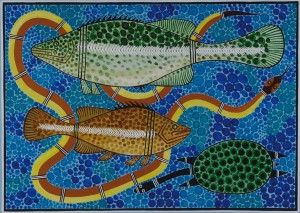Wake Up World April 3 2014
 A little over two years ago, the somewhat intriguing headline “Gone fishing, 42,000 years ago” introduced an article in the Sydney Morning Herald newspaper which was based on the findings of a team of Australian archaeologists from the Australian National University (Canberra). Their 2011 discovery of a fish hook at East Timor, along with evidence of deep-sea fishing occurring up to 42,000 years ago, carried with it some unexpected repercussions and was the catalyst for a considerable reshuffling of deck-chairs on an African boat that supposedly made landfall in Australia around 50,000 years ago.
A little over two years ago, the somewhat intriguing headline “Gone fishing, 42,000 years ago” introduced an article in the Sydney Morning Herald newspaper which was based on the findings of a team of Australian archaeologists from the Australian National University (Canberra). Their 2011 discovery of a fish hook at East Timor, along with evidence of deep-sea fishing occurring up to 42,000 years ago, carried with it some unexpected repercussions and was the catalyst for a considerable reshuffling of deck-chairs on an African boat that supposedly made landfall in Australia around 50,000 years ago.
The problem is that the claims made by these scientists seem to contradict an elemental assumption underpinning what another group of eminent genetic experts concluded when examining the genome patterns found within a hundred year old piece of hair belonging to an Australian Aboriginal man. Quite simply as things stand, the conclusions of each investigation are in open defiance to each other and logic demands that at least one theory has to be wrong.
Gone Fishing… and Hunting
The recent archaeological dig at East Timor bears witness that modern humans possessed “quite sophisticated technology and watercraft”, and through use of hooks (like the one discovered) were engaged in “deep-sea fishing for large delicacies such as tuna”. The Australian researchers insist that a high degree of skill was essential “in catching the types of fish that would be challenging even today”.
If relying upon the accepted pre-historical narrative, the people exhibiting these “amazingly advanced maritime skills” must have originated in Africa. “An archaeologist at the Australian National University, Sue O’Connor” saw this settlement and activity as proof of African mariners’ ocean transit to Australia. She believes that “the first people who arrived in Australia at least 50,000 years ago must have had boats because they had to cross hundreds of kilometers of deep ocean trenches to get here from south-east Asia”.
Possibly… but there is more to this discovery than one solitary hook.
The analysis of bones found in the “oldest area of occupation… dated at 38,000 and 42,000 years old” of which “50% came from ocean fish, such as tuna and trevally” also included “small amounts of marine turtles, rats, bats, birds and snakes”. These people employed a highly sophisticated technology when deep-sea fishing and obviously co-operated extensively in fishing, sailing and living together. But not only did they sail and fish upon the open seas, food from coastal and inland areas was also consumed. The sea, although used often, was not the only place to hunt and gather food.
Until this discovery in East Timor, the only evidence of ancient maritime technology of this sophistication was the hypothetical settlement by Africans in Australia. At first glance this belief seems to be supported by the 42,000 year old dicovery in Timor. However, further analysis and comparison to recent genome research casts considerable doubt, and raises questions that can neither be answered nor accommodated by the Out-of-Africa theory.
